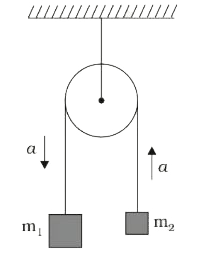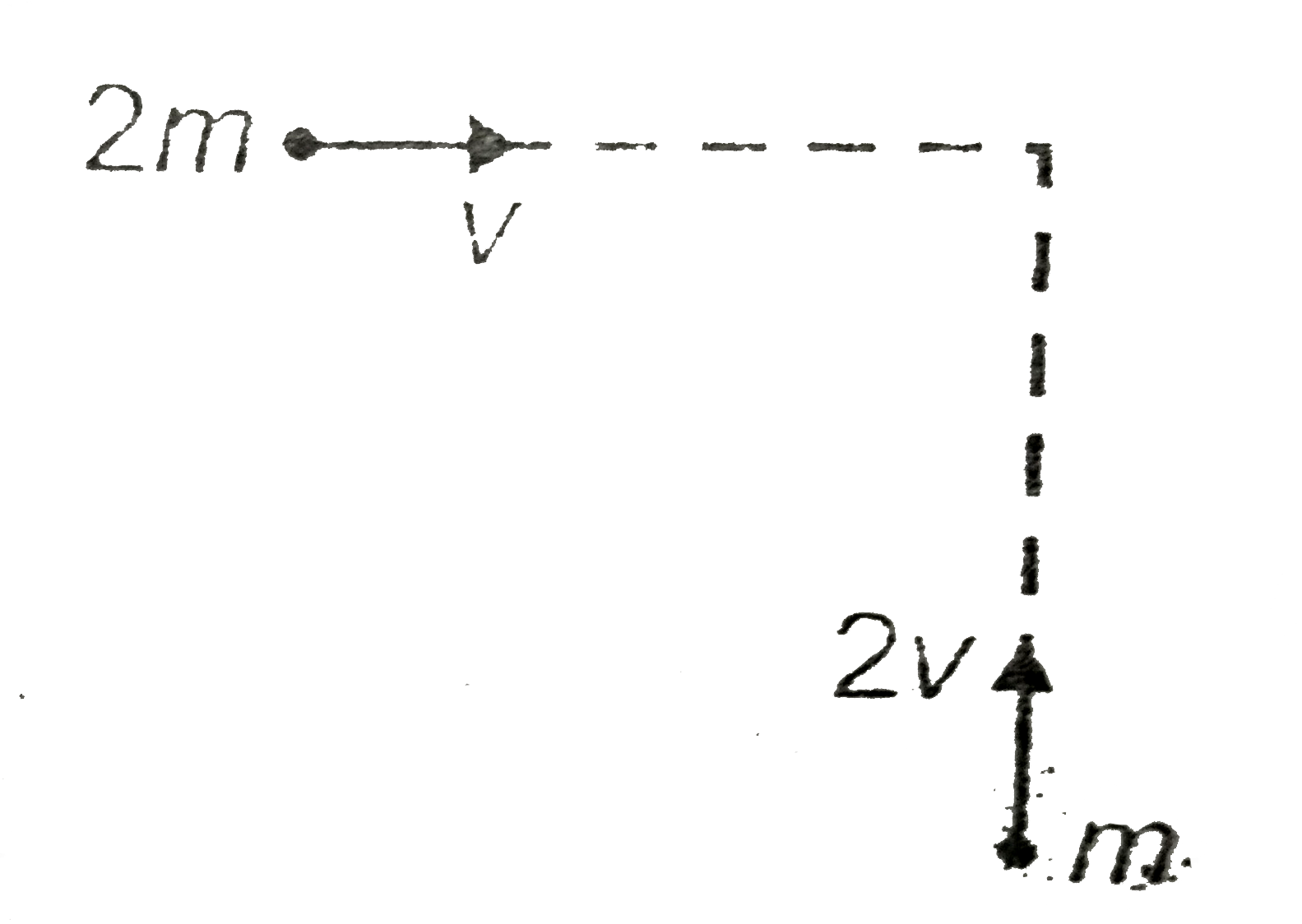Two bodies of masses m and 2m are moving in same direction with speed 2v and v respectively just after collision body of mass m come to rest and body of mass 2m splits in two equal parts and move at 45∘ from initial direction of body of mass m. Find out speed of one part after collision
2√2v
√2v
2v
None of these
The correct Answer is:A
To solve the problem step-by-step, we will use the principle of conservation of momentum.
Step 1: Understand the initial conditions
We have two bodies:
- Body 1 (mass = m) moving with speed = 2v
- Body 2 (mass = 2m) moving with speed = v
Step 2: Write down the initial momentum
The total initial momentum (before collision) can be calculated as:
Initial Momentum=(m⋅2v)+(2m⋅v)=2mv+2mv=4mv
Step 3: Analyze the situation after the collision
After the collision:
- Body 1 (mass = m) comes to rest, so its final velocity = 0.
- Body 2 (mass = 2m) splits into two equal parts, each of mass = m, moving at an angle of 45° from the initial direction of Body 1.
Let the speed of each part after the collision be V′.
Step 4: Write down the final momentum
The final momentum consists of:
- The momentum of Body 1: m⋅0=0
- The momentum of the two parts of Body 2:
- For the first part: m⋅V′cos(45∘)
- For the second part: m⋅V′cos(45∘)
Since both parts move at 45°, their vertical components will also contribute to the momentum. The horizontal components of both parts will be:
Final Momentum=2⋅(m⋅V′⋅cos(45∘))=2m⋅V′⋅1√2=2mV′√2
Step 5: Set up the conservation of momentum equation
According to the conservation of momentum:
Initial Momentum=Final Momentum
4mv=2mV′√2
Step 6: Simplify the equation
We can cancel m from both sides (assuming m≠0):
4v=2V′√2
Step 7: Solve for V′
To isolate V′, we multiply both sides by √2:
4v√2=2V′
Now, divide both sides by 2:
V′=2v√2
Conclusion
The speed of one part after the collision is:
V′=2√2v
We have two bodies:
- Body 1 (mass = m) moving with speed = 2v
- Body 2 (mass = 2m) moving with speed = v
The total initial momentum (before collision) can be calculated as:
Initial Momentum=(m⋅2v)+(2m⋅v)=2mv+2mv=4mv
After the collision:
- Body 1 (mass = m) comes to rest, so its final velocity = 0.
- Body 2 (mass = 2m) splits into two equal parts, each of mass = m, moving at an angle of 45° from the initial direction of Body 1.
The final momentum consists of:
- The momentum of Body 1: m⋅0=0
- The momentum of the two parts of Body 2:
- For the first part: m⋅V′cos(45∘)
- For the second part: m⋅V′cos(45∘)
Final Momentum=2⋅(m⋅V′⋅cos(45∘))=2m⋅V′⋅1√2=2mV′√2
According to the conservation of momentum:
Initial Momentum=Final Momentum
4mv=2mV′√2
We can cancel m from both sides (assuming m≠0):
4v=2V′√2
To isolate V′, we multiply both sides by √2:
4v√2=2V′
Now, divide both sides by 2:
V′=2v√2
The speed of one part after the collision is:
V′=2√2v
Topper's Solved these Questions
Similar Questions
Two bodies of masses m1andm2(<m1) are connected to the ends of a massless cord and allowed to move as shown in figure. The pulley is both massless and frictionless. The acceleration of the centre of mass is (m1−m2)n(m1+m2)2g. Find the value of n.
 View Solution
View SolutionTwo particles of masses m and 2m moving in opposite directions collide elastically with velocity 2v and v, respectiely. Find their velocities after collision.
 View Solution
View SolutionTwo balls of masses m and 2m moving in opposite directions collide head on elastically with velocities v and 2v. Find their velocities after collision.
View SolutionTwo balls of masses m and 2m moving in opposite directions collide head on elastically with velocities v and 2v. Find their velocities after collision.
View SolutionTwo particle of masses m and 2m are coliding elastically as given in figure. If V1 and V2 speed of particle just after collision then
_2019_CBT5_E01_051_Q01.png) View Solution
View SolutionTwo bodies A and B of same mass are moving in opposite direction on same line with speeds v0 and V03 respectively.If they collide elastically,then speed of body A after collision is
View SolutionTwo bodies A and B of same mass are moving in opposite direction on same line with speeds v0 and V03 respectively.If they collide elastically,then speed of body A after collision is
View SolutionA moving body of mass m makes a head on elastic collision with another body of mass 2m which is initially at rest. Find the fraction of kinetic energy lost by the colliding particles after collision.
View SolutionTwo particles of mass 2m and m moving with speed v and 2v respectively pependicular to each other collides perfectly inelastically, then

Speed of the particles after collisionView SolutionTwo bodies of masses m and 2m are moving along positive x and y axes respectively with equal speed 4ms−1. They collide at origin and stick together. The final velocity of combined mass is
View Solution

